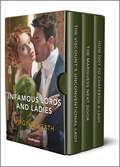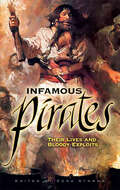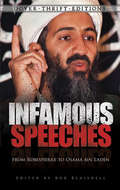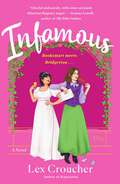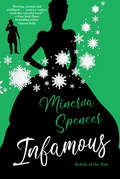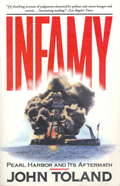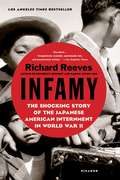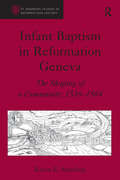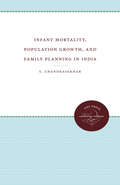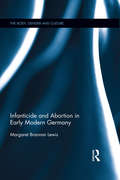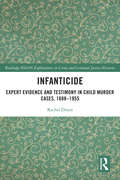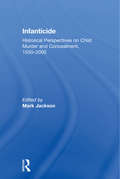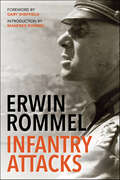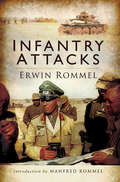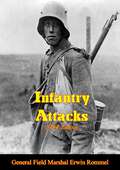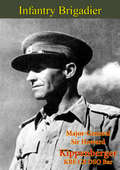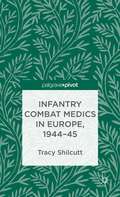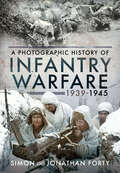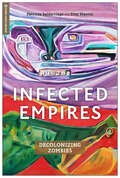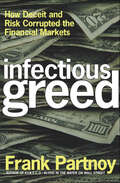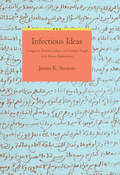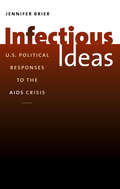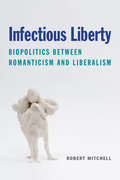- Table View
- List View
Infamous Lords and Ladies: A Regency Romance Collection (The Talk of the Beau Monde)
by Virginia HeathHarlequin Historical brings you three spicy Regency romances in one collection. Follow three unconventional sisters as they meet their matches in three rebellious gentlemen – and become the talk of Society! The Viscount's Unconventional Lady After Lord Eastwood&’s scandalous divorce made him?infamous, he is reluctant to return to London society. To halt the rumor mill, he?should marry?a quiet noblewoman—instead it&’s vibrant artist Faith Brookes who&’s caught his attention. They are the?least suitable match,?so why is he like a moth to a flame? The Marquess Next Door To avoid an unwanted suitor at a ball, Hope Brookes asks another gentleman to rescue her. He obliges—with a surprisingly passionate kiss! He's revealed as her sinfully handsome new neighbor, Lucius, Marquess of Thundersley...? How Not to Chaperon a Lady Chaperoning Charity Brookes while she&’s on a singing tour should be easy for Griffith Philpot—he&’s spent his whole life sparring with her over her flighty ways! But as he discovers that she&’s much more than the impetuous girl he thought he knew, a passion ignites between them… Previously published as: The Talk of the Beau Monde miniseries Three unconventional sisters for three infamous lords Book 1:?The Viscount's Unconventional Lady Book 2:?The Marquess Next Door Book 3:?How Not to Chaperon a Lady
Infamous Pirates: Their Lives and Bloody Exploits
by Ezra StrongDespite his relatively conventional background—wealthy family, excellent education—Captain Misson of Provence went to sea at age sixteen, and in following his utopian vision became one of the forebears of the French Revolution. When, due to misadventure, he became the saintly pirate captain of the ship Victoire (renamed Republic of the Sea), he and his crew hoisted their own version of the Jolly Roger—a pure white flag with the motto "For God and Liberty." A legendary figure in the annals of piracy, his story has captured the imaginations of writers as diverse as Daniel Defoe and William S. Burroughs. Lord Byron was said to have written of him, "He was the mildest-mannered man that ever scuttled a ship or cut a throat." While some accounts of his life differ, Captain Kidd (Robert, also known as William)—a native Scot who later settled in New York—was a privateersman hired by the Governor General of the Colonies to hunt down pirates. When he failed to fulfill his mission and was deemed a pirate himself, he was eventually captured and ignominiously hanged at London's Execution Dock for the very crimes he was meant to eradicate.These are among the many tales of history's most notorious pirates presented in this volume. Originally published in the nineteenth century—when these outlaws were still the scourge of the high seas—this collection is packed with true accounts of extraordinary exploits and grim executions, vicious battles and gruesome bloodshed, soaring triumphs and stinging defeats.
Infamous Speeches: From Robespierre to Osama bin Laden
by Bob BlaisdellThis anthology comprises some of history's most hateful public addresses, consisting of speeches invoking racism, genocide, anti-Semitism, terrorism, and other extreme views. Selections range from an oration by Robespierre during the Reign of Terror that followed the French Revolution to Osama bin Laden's threats related to the terrorist actions of 9/11.Additional speeches include Andrew Jackson's Seventh Annual Message to Congress in 1835, promoting the Indian Removal Act; Jefferson Davis' 1861 announcement of Southern secession; and Joseph R. McCarthy's "Wheeling" speech of 1950, in which the senator claimed knowledge of Communist loyalists within the U. S. government. Other speakers include Hitler, Mussolini, Mao Tse-Tung, and Stalin. Each speech features a brief introduction that places it in historical context.
Infamous: A Novel
by Lex CroucherNamed a Most Anticipated Romance of 2023 by Goodreads and Bookpage"Lex Croucher is one of my favorite rom-com authors, and they should be yours, too." ––Casey McQuiston, #1 bestselling author of Red, White & Royal Blue"Croucher infuses this energetic Regency era friends-to-lovers sapphic romance with zany wit, joie de vivre, and a distinctive literary bent." ––Publishers WeeklyTwenty-two-year-old aspiring writer Edith (“Eddie”) Miller and her best friend Rose have always done everything together―from climbing trees and sneaking bottles of wine, to extensive kissing practice. But Rose has started talking about marriage, and Eddie is horrified. Why can’t they continue as they always have?Then Eddie meets charming, renowned poet Nash Nicholson––a rival of Lord Byron, if he does say so himself––and he welcomes her into his world of eccentric artists and boundary-breaking visionaries. When Eddie receives an invitation to Nash's crumbling Gothic estate in the countryside, promising inspiration (and time to finish her novel, a long-held dream), she eagerly agrees. But the pure hedonism and debauchery that ensues isn’t exactly what she had in mind, and Eddie soon finds herself torn between her complicated feelings for Rose and her equally complicated dynamic with Nash, whose increasingly bad behavior doesn’t match up to her vision for her literary hero.Will Eddie be forced to choose between her friendship with Rose and her literary dreams––or will she be able to write her own happily ever after?
Infamous: A Witty Historical Regency Romance Book (Rebels of the Ton #3)
by Minerva SpencerBridgerton fans and readers of Scarlett Scott, Darcy Burke, and K.J. Jackson won&’t want to miss this smart and stirring new holiday love story from the acclaimed author of Outrageous. &“Riveting, sensual, and intelligent . . . romance readers need this splendid book!&” —USA Today bestselling author Vanessa KellyA mean girl reformed . . . Once the reigning beauty of her social set, Celia—whom the newspapers dubbed Lady Infamous—has fallen on hard times and is practically destitute, her reputation in shreds. When Celia is forced to attend a society wedding as a companion to an elderly guest, she must confront the clique she once commanded; the gentleman she'd once hoped to marry—who is now wed to a girl Celia relentlessly taunted; and the powerful man who ruined her life a decade before—and is threatening to do so again. . . . A hero transformed . . . Then there is Richard, the studious boy Celia used to ridicule, who is now gorgeous, wealthy, and more-than-a-little famous. As a youth, Richard was infatuated with Celia. He still seems intrigued, but Celia has acquired a shocking secret along with her hard-won humility. Will it put an end to the love blossoming between them? Does she have the courage to find out? &“Readers will be delighted.&” —Publishers Weekly
Infamy
by John TolandBestselling author and historian John Toland's expertise and skill as a narrator were awarded with the Pulitzer Prize for his sweeping Rising Sun. In Infamy, Toland extends and corrects his account of the events leading up to Japan's attack on Pearl Harbor, addressing persistent questions: Could FDR have engineered a conspiracy to get the US into the War? Did high-level military and civilian leaders lie under oath? Were the wrong men held culpable in order to protect Washington? Accessing formerly secret government, military, and diplomatic records--including the account of the then anonymous and controversial "Seaman Z"--Toland masterfully reevaluates what we know about this infamous act of aggression against the US.
Infamy: The Shocking Story of the Japanese-American Internment in World War II
by Richard ReevesLess than three months after Japan bombed Pearl Harbor and inflamed the nation, President Roosevelt signed an executive order declaring parts of four western states to be a war zone operating under military rule. The U.S. Army immediately began rounding up thousands of Japanese-Americans, sometimes giving them less than 24 hours to vacate their houses and farms. For the rest of the war, these victims of war hysteria were imprisoned in primitive camps. In Infamy, the story of this appalling chapter in American history is told more powerfully than ever before. Acclaimed historian Richard Reeves has interviewed survivors, read numerous private letters and memoirs, and combed through archives to deliver a sweeping narrative of this atrocity. Men we usually consider heroes-FDR, Earl Warren, Edward R. Murrow-were in this case villains, but we also learn of many Americans who took great risks to defend the rights of the internees. Most especially, we hear the poignant stories of those who spent years in "war relocation camps," many of whom suffered this terrible injustice with remarkable grace. Racism, greed, xenophobia, and a thirst for revenge: a dark strand in the American character underlies this story of one of the most shameful episodes in our history. But by recovering the past, Infamy has given voice to those who ultimately helped the nation better understand the true meaning of patriotism.
Infant Baptism in Reformation Geneva: The Shaping of a Community, 1536–1564 (St Andrews Studies in Reformation History)
by Karen E. SpierlingThis book examines the beliefs, practices and arguments surrounding the ritual of infant baptism and the raising of children in Geneva during the period of John Calvin's tenure as leader of the Reformed Church, 1536-1564. It focuses particularly on the years from 1541 onward, after Calvin's return to Geneva and the formation of the Consistory. The work is based on sources housed primarily in the Genevan State Archives, including the registers of the Consistory and the City Council. While the time period of the study may be limited, the approach is broad, encompassing issues of theology, church ritual and practices, the histories of family and children, and the power struggles involved in transforming not simply a church institution but the entire community surrounding it. The overarching argument presented is that the ordinances and practices surrounding baptism present a framework for relations among child, parents, godparents, church and city. The design of the baptismal ceremony, including liturgy, participants and location, provided a blueprint of the reformers' vision of a well ordered community. To comprehend fully the development and spread of Calvinism, it is necessary to understand the context of its origins and how the ideas of Calvin and his Reformed colleagues were received in Geneva before they were disseminated throughout Europe and the world. In a broad sense this project explores the tensions among church leaders, city authorities, parents, relatives and neighbours regarding the upbringing of children in Reformed Geneva. More specifically, it studies the practice of infant baptism as manifested in the baptism ceremony in Geneva, the ongoing practices of Catholic baptism in neighbouring areas, and the similarities and tensions between these two rituals.
Infant Mortality, Population Growth, and Family Planning in India: An Essay On Population Problems And International Tensions (Routledge Library Editions: Development Ser.)
by S. ChandrasekharThis study surveys the level, causes, and course of infant mortality in India during the last seventy years. Besides this historical survey, the book examines the implications of high and low infant mortality on the country's major problems of population growth and the current population policy designed to reduce the birth rate through family planning.Originally published 1972.A UNC Press Enduring Edition -- UNC Press Enduring Editions use the latest in digital technology to make available again books from our distinguished backlist that were previously out of print. These editions are published unaltered from the original, and are presented in affordable paperback formats, bringing readers both historical and cultural value.
Infanticide and Abortion in Early Modern Germany ("The Body, Gender and Culture" #19)
by Margaret Brannan LewisThis book is the first work to look at the full range of three centuries of the early modern period in regards to infanticide and abortion, a period in which both practices were regarded equally as criminal acts. Faced with dire consequences if they were found pregnant or if they bore illegitimate children, many unmarried women were left with little choice. Some of these unfortunate women turned to infanticide and abortion as the way out of their difficult situation. This book explores the legal, social, cultural, and religious causes of infanticide and abortion in the early modern period, as well as the societal reactions to them. It examines how perceptions of these actions taken by desperate women changed over three hundred years and as early modern society became obsessed with a supposed plague of murderous mothers, resulting in heated debates, elaborate public executions, and a media frenzy. Finally, this book explores how the prosecution of infanticide and abortion eventually helped lead to major social and legal reformations during the age of the Enlightenment.
Infanticide: Expert Evidence and Testimony in Child Murder Cases, 1688–1955 (Routledge SOLON Explorations in Crime and Criminal Justice Histories)
by Rachel DixonInfanticide examines medical expert evidence in infanticide cases, focusing specifically on the shifting notion of "certainty" in medical testimony. Beginning in the Early Modern period and concluding in the mid-twentieth century, it considers how courts determined whether an infant died from natural causes or other reasons, including violence. The book explores expert evidence in cases of infanticide and examines the extent of certainty created by medical specialists who founded their testimony on anatomical exploration and science. As the book progresses, it becomes clear that medical specialists were unable to scientifically establish cause of death and in doing so conveyed uncertainty in court proceedings. Rather than being regarded as a professional failing, Dixon argues that the uncertainty created by medical specialists redirected the outcomes of infanticide cases. The combination of uncertainty and the changing perceptions of infanticidal women by the court lead juries to find infanticidal women not guilty of a capital offence in many cases. This book will be of great interest to students and scholars of Criminology, Law and History.
Infanticide: Historical Perspectives on Child Murder and Concealment, 1550–2000
by Mark JacksonThe history of infanticide from the 16th through to the late 20th century is the subject of this volume. Collectively, the contributions explore how the concealment of pregnancy, birth and death, particularly by unmarried women, became a central preoccupation of witnesses, doctors, courts and legislatures concerned with suspicious infant deaths. While the emphasis is upon Britain, original and stimulating accounts of infanticide accusations and trials in France, Germany, and South Africa provide compelling comparative analyses. Presenting a series of case studies, successive chapters expose striking continuities, across both time and space, in the social history of infanticide. Clearly written, focusing on a range of original cases and documents, and addressing critical historiographical questions, Infanticide will be invaluable to historians and students researching the social history of medicine, law, crime, and gender. In addition, it will appeal to lawyers, doctors, and others interested in understanding the historical roots of modern debates about infanticide.
Infantry Attacks
by Erwin RommelLegendary German general Erwin Rommel analyzes the tactics that led to his success. Field Marshal Erwin Rommel exerted an almost hypnotic influence not only over his own troops but also over the Allied soldiers of the Eighth Army in the Second World War. Even when the legend surrounding his invincibility was overturned at El Alamein, the aura surrounding Rommel himself remained unsullied. In this classic study of the art of war Rommel analyses the tactics that lay behind his success. First published in 1937 it quickly became a highly regarded military textbook, and also brought its author to the attention of Adolph Hitler. Rommel was to subsequently advance through the ranks to the high command in the Second World War. As a leader of a small unit in the First World War, he proved himself an aggressive and versatile commander with a reputation for using the battleground terrain to his own advantage, for gathering intelligence, and for seeking out and exploiting enemy weaknesses. Rommel graphically describes his own achievements, and those of his units, in the swift-moving battles on the Western Front, in the ensuing trench warfare, in the 1917 campaign in Romania, and in the pursuit across the Tagliamento and Piave rivers. This classic account seeks out the basis of his astonishing leadership skills, providing an indispensable guide to the art of war.
Infantry Attacks (Zenith Military Classics Ser.)
by Erwin RommelField Marshal Erwin Rommel exerted an almost hypnotic influence not only over his own troops but also over the Allied soldiers of the Eighth Army in the Second World War. Even when the legend surrounding his invincibility was overturned at El Alamein, the aura surrounding Rommel himself remained unsullied. In this classic study of the art of war Rommel analyses the tactics that lay behind his success. First published in 1937 it quickly became a highly regarded military textbook, and also brought its author to the attention of Adolph Hitler. Rommel was to subsequently advance through the ranks to the high command in the Second World War. As a leader of a small unit in the First World War, he proved himself an aggressive and versatile commander, with a reputation for using the battleground terrain to his own advantage, for gathering intelligence, and for seeking out and exploiting enemy weaknesses. Rommel graphically describes his own achievements, and those of his units, in the swift-moving battles on the Western Front, in the ensuing trench warfare, in the 1917 campaign in Romania, and in the pursuit across the Tagliamento and Piave rivers.This classic account seeks out the basis of his astonishing leadership skills, providing an indispensable guide to the art of war written by one of its greatest exponents.
Infantry Attacks [1944 Edition]
by General Field Marshal Erwin RommelInfantry Attacks is a classic text in the field of military strategy. Written by German Field Marshal Erwin Rommel, it was first published in 1937 as a journal-esque chronicle of the author's experiences in World War I and the lessons he learned there. In it, he provides detailed accounts of a variety of military strategies that rely on speed, deception, and deep penetration into enemy territory to intimidate and surprise opposing forces. Considered by his troops and enemies alike to be a humane, professional and immensely skilled officer, Rommel's use of intimidation and the advantage of surprise often forced enemies to surrender quickly, thereby avoiding unnecessary risk of injury and death for his troops (and their enemies), exertion, and expenditure of ammunition.Infantry Attacks was widely read by soldiers and military leaders upon its release and has become something of a staple in military education, providing a detailed glimpse into the tactics of an extremely effective and widely respected officer. It has been studied extensively throughout the West, particularly in the United States. The revered General George S. Patton is said to have been heavily influenced by this text.Rommel was appointed to the rank of high commander by Adolf Hitler in part because of the success of this book. Such positions were ordinarily reserved for members of old military families and the Prussian aristocracy, so this assignment spoke to Rommel's competence and the influence of his writing. Rommel went on to lead Hitler's Afrika Korps in North Africa. Although he planned to release a sequel based on his experiences there, he was unable to complete the manuscript before his death in 1944.-Print ed.
Infantry Brigadier
by Major-General Sir Howard Kippenberger KBE CB DSO & BarContains numerous Illustrations and MapsMajor-General Howard “Kip” Kippenberger still stands as one of the most famous soldiers ever produced by New Zealand. He saw the brutal slaughter of the First World War as an officer of the NZEF before being seriously wounded in 1916. Following the outbreak of the Second World War, “Kip” was appointed commander of the 20th Battalion of the newly re-constituted New Zealand Forces. He led his Kiwis with distinction in Greece and Crete, before promotion to Brigadier of the 5th Brigade, which fought in the desert during the North African Campaign. In the difficult campaigning in the mountains of Italy, Kippenberger was an inspirational leader and pushed his men forward in command of an entire Division. However his luck couldn’t hold as he stepped on a landmine near Monte Cassino, despite the amputation of his two feet he remained with his men until the last of his men were returned to New Zealand.“His own autobiographical account of his war, Infantry Brigadier, first appeared in 1949 and was acclaimed a classic in its field. Unit and campaign histories indicate how high were the standards he demanded of the authors. Taken together, they constitute a formidable achievement and will remain a monument to a man who inspired great efforts in soldiers and writers alike.”—Professor Angus Ross
Infantry Combat
by John AntalYou are the neophyte platoon leader in this informative and entertaining, interactive work from the author of Armor Attacks.
Infantry Combat Medics in Europe, 1944–45
by Tracy ShilcuttMedics learned quickly to ignore standing operating procedures in order to save, lives but tensions within infantry units created a paradoxical culture of isolation and acceptance. This groundbreaking work examines training and combat experiences of soldiers working in Battalion Aid Stations and those who went as aid men to the line companies.
Infantry Warfare, 1939–1945: A Photographic History
by Simon Forty Jonathan FortyThe infantry can always be found at the sharp end of the battlefield. You may be able to crush an opponent with armour or artillery, but there’s only one way to take and hold ground and that’s with riflemen – the ‘poor bloody infantry’. And it is the infantrymen of the Second World War – from all sides, Allied and Axis – who are the subject of this highly illustrated history. It uses over 400 wartime photographs plus contemporary documents and other illustrations to show the developments in equipment, training and tactical techniques and to give an insight into the experience of the infantry soldier during the conflict. Although the infantry were critical to the war effort, their contribution is often overshadowed by the more dramatic roles played by soldiers with more specialized skills – like tank crew, paratroopers and special forces. They also suffered devastating casualties, in particular during the last phase of the war in the west when around 20 per cent of an infantry division’s riflemen were likely to die and over 60 per cent could expect to be wounded. So as well as describing how the infantry fought, the authors look at the motivation which kept them fighting in awful conditions and despite brutal setbacks. The result is a thorough, detailed and revealing portrait of infantry warfare over seventy years ago.
Infected Empires: Decolonizing Zombies (Global Media and Race)
by Patricia Saldarriaga Emy ManiniGiven the current moment--polarized populations, increasing climate fears, and decline of supranational institutions in favor of a rising tide of nationalisms-- it is easy to understand the proliferation of apocalyptic and dystopian elements in popular culture. Infected Empires examines one of the most popular figures in contemporary apocalyptic film: the zombie. This harbinger of apocalypse reveals bloody truths about the human condition, the wounds of history, and methods of contending with them. Infected Empires considers parallels in the zombie genre to historical and current events on different political, theological and philosophical levels, and proposes that the zombie can be read as a figure of decolonization and an allegory of resistance to oppressive structures that racialize, marginalize, disable, and dispose of bodies. Studying films from around the world, including Latin America, Asia, Africa, the US, and Europe, Infected Empires presents a vision of a global zombie that points toward a posthuman and feminist future.
Infectious Diseases along the Silk Roads: The Spread of Parasitoses and Culture Past and Today (Parasitology Research Monographs #17)
by Heinz Mehlhorn Zhongdao Wu Xiaoying WuThe heart of this volume is exploring the links between human disease spread and the broad Silk Road trading networks which connect Eurasian civilizations past and today. Compiled by an international team of subject authors, this book includes two themed parts. Readers are first introduced into history naming, former, present and future routes of the Silk Road, representing the longest trade way and culture diffuser in the world. The second part contains the main book focus and addresses medical research as well as individual diseases and parasite groups from the region in detail. By drawing an arc between the past and present disease situation, the authors trace how parasites and vectors spread around the globe, and what impact infectious diseases had and will have upon human civilizations.Through its interdisciplinary character this book will be enjoyed by interested readers from the fields of parasitology and palaeoparasitology, medical sciences and public health, as well as cultural history.
Infectious Greed: How Deceit and Risk Corrupted the Financial Markets
by Frank PartnoyFrom the bestselling author of F.I.A.S.C.O., a riveting chronicle of the rise of dangerous financial instruments and the growing crisis in American businessOne by one, major corporations such as Enron, Global Crossing, and Worldcom imploded all around us, prey to a greed-driven culture and dubious or illegal corporate finance and accounting.In a compelling and disturbing narrative, Frank Partnoy's Infectious Greed brings to bear all of his skills and experience as a securities attorney, financial analyst, law professor, and bestselling author to tell the story of the rise of the trading instruments and corporate financial structures that imperil the economic health of the country. Starting in the mid-1980s with the introduction of the first proto-derivatives, and taking us through such high-profile disasters as Barings Bank and Long Term Capital Management, Partnoy traces a seamless progression to today's dangerous manipulations. He documents how each new level of financial risk and complexity obscured the sickness of the company in question, and required ever more ingenious deceptions. It's an alarming story, but Partnoy offers a clear vision of how we can step back from the precipice.
Infectious Ideas: Contagion in Premodern Islamic and Christian Thought in the Western Mediterranean
by Justin K. StearnsInfectious Ideas is a comparative analysis of how Muslim and Christian scholars explained the transmission of disease in the premodern Mediterranean world.How did religious communities respond to and make sense of epidemic disease? To answer this, historian Justin K. Stearns looks at how Muslim and Christian communities conceived of contagion, focusing especially on the Iberian Peninsula in the aftermath of the Black Death. What Stearns discovers calls into question recent scholarship on Muslim and Christian reactions to the plague and leprosy. Stearns shows that rather than universally reject the concept of contagion, as most scholars have affirmed, Muslim scholars engaged in creative and rational attempts to understand it. He explores how Christian scholars used the metaphor of contagion to define proper and safe interactions with heretics, Jews, and Muslims, and how contagion itself denoted phenomena as distinct as the evil eye and the effects of corrupted air. Stearns argues that at the heart of the work of both Muslims and Christians, although their approaches differed, was a desire to protect the physical and spiritual health of their respective communities.Based on Stearns's analysis of Muslim and Christian legal, theological, historical, and medical texts in Arabic, Medieval Castilian, and Latin, Infectious Ideas is the first book to offer a comparative discussion of concepts of contagion in the premodern Mediterranean world.
Infectious Ideas: U.S. Political Responses to the AIDS Crisis
by Jennifer BrierIn Infectious Ideas, Jennifer Brier convincingly argues that the AIDS epidemic had a profound effect on the American political landscape. Viewing contemporary history from the perspective of the AIDS crisis, she provides rich, new understandings of the complex social and political trends of the post-1960s era. Brier describes how AIDS workers--in groups as disparate as the gay and lesbian press, AIDS service organizations, private philanthropies, and the State Department--influenced American politics, especially on issues such as gay and lesbian rights, reproductive health, racial justice, and health care policy, even in the face of the expansion of the New Right. Indeed, the book shows that efforts to deal with AIDS produced significant fissures in the conservative movement during this period, especially when the State Department and USAID adopted AIDS as a centerpiece of its diplomatic strategy, including the distribution of millions of condoms overseas. Infectious Ideasplaces recent social, cultural, and political events in a new light, making an important contribution to our understanding of the United States at the end of the twentieth century.
Infectious Liberty: Biopolitics between Romanticism and Liberalism (Lit Z)
by Robert MitchellInfectious Liberty traces the origins of our contemporary concerns about public health, world population, climate change, global trade, and government regulation to a series of Romantic-era debates and their literary consequences. Through a series of careful readings, Robert Mitchell shows how a range of elements of modern literature, from character-systems to free indirect discourse, are closely intertwined with Romantic-era liberalism and biopolitics. Eighteenth- and early-nineteenth century theorists of liberalism such as Adam Smith and Thomas Malthus drew upon the new sciences of population to develop a liberal biopolitics that aimed to coordinate differences among individuals by means of the culling powers of the market. Infectious Liberty focuses on such authors as Mary Shelley and William Wordsworth, who drew upon the sciences of population to develop a biopolitics beyond liberalism. These authors attempted what Roberto Esposito describes as an “affirmative” biopolitics, which rejects the principle of establishing security by distinguishing between valued and unvalued lives, seeks to support even the most abject members of a population, and proposes new ways of living in common.Infectious Liberty expands our understandings of liberalism and biopolitics—and the relationship between them—while also helping us to understand better the ways creative literature facilitates the project of reimagining what the politics of life might consist of.Infectious Liberty is available from the publisher on an open-access basis.
